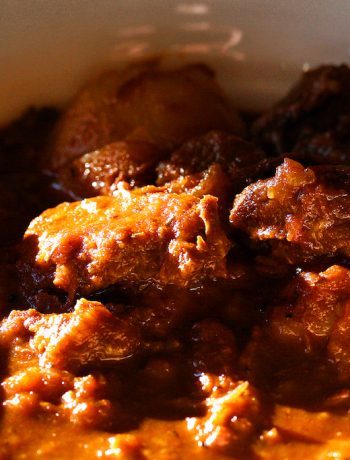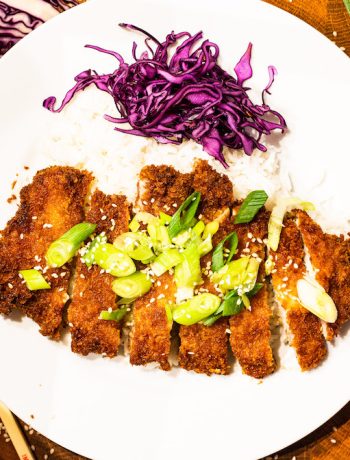Pho is the ubiquitous noodle soup that is served all over Vietnam. It came into being in the early 1900s, and was spread first of all from North to South Vietnam by refugees fleeing the Commies, and later all over the world by refugees of the US-led Vietnam War. Pho even makes it into Blade Runner in the scene where Deckard eats something that looks a lot like it in the rain soaked market of Los Angeles, 2019.
To try to provide a definitive recipe for Pho would be like trying to use every religious text ever written to define God. That said, if we accept that God is offered by all authorities as an ethereal, all-seeing power beyond our ken, then looking at recipes for pho continually throws up two common elements: 1. You have to have roasted onion and ginger in there (they must be flame-roasted); 2. The toasted spice are immovable. Everything else is up for grabs – even the style of noodle.
To make the most common pho tái (beef pho), vegetables and charred onion and ginger are stewed along with beef shank and bones for hours and hours until the whole house smells of the food to come. Whole chickens can be added just to add more flavour – some folks add pure MSG. Thin, flat rice noodles are soaked in water, and placed in a bowl. Toppings of shredded leaves, spring onions and other bits of plant life are placed on top, along with raw, thinly sliced lean beef, and torn pieces of the butter-soft slow-cooked shank. The hot broth is poured over, which heats the noodles and just cooks the steak. The soup is drunk with a spoon, while the noodles and toppings are fished out with chopsticks – the toppings dipped in a sweet chilli sauce called nuoc cham.
Although traditionally made with beef or chicken, Pho does not have to be a meaty dish. The Vietnamese will respond well when asked for ‘chay,’ which is their term for vegetarian. There are immense numbers of chay dishes produced all over the country, and of course, there is pho chay. When I was challenged by a friend to come up with a vegetarian Asian dish, rather than going for something Chinese that we might buy from the local take-away, I decided to go down river (“That’s ‘Nam, sir.”). I started by looking at pho tái, working out the bits that always survived adaptation, and then seeking out a way of doing a pho chay, but with those common elements retained. Then I had to tweak it again to make sure that everything could be found in a provincial branch of Tesco.
This dish is actually more than vegetarian – use of rice noodles means it is fully, bang-up vegan. It is also super-adaptable. You can make the stock out of anything handy as long as the ginger, onion and spices go in. As for the toppings, you can empty the fridge into that.
At first glance, the pho recipe here looks complicated with a lot of ingredients, and many steps, but you can break it down into three things: 1. You need to make a stock; 2. You need to cook some noodles; and 3. You need to add some toppings. Most of the ingredients wind up in the stock. There are more ingredients in a pho chay than in beefy pho tái for the simple reason that losing the beef puts a big, cow-shaped hole in the flavour of the broth. Making up for the absent cow means that a lot of different veg needs to be added – you need at least five kinds to make the stock complex enough. The other thing that is missing from pho chay is fish sauce. This is replaced with soy sauce. If, like my friend who asked for this recipe, you are not keen on any one element (e.g. ginger) just add it anyway. The stock is so complex, that no one flavour dominates it.
Pho chay
Ingredients
- 4 litres of water
- 1 medium onions, peeled and halved
- 1 thumb of ginger root
- 1 carrot
- 1 leek
- 1 apple
- 1 pear
- 1 corn cob
- 3 pak choi
- 50ml soy sauce
- 1 tbsp salt
- 1 tbsp palm sugar
- 1 lemon grass stalk, snapped
- 2 cinnamon sticks
- 10 green cardamom pods
- 6 cloves
- 3 star anise
- 2 tbsp vegetable oil
- 350g pack of tofu
- 250g chestnut mushrooms, sliced
- Small handful of dried wild mushrooms
- 2 tsp Chinese five spice (see notes)
- 4 portions of noodles (linguine-sized; 150g per portion 'ready for wok;' 100g dried)
- 1 bunch of spring onions, root removed and cut into 3-inch lengths and sliced thinly on the long axis
- 1 bunch of coriander, chopped once only
- 1 red onion, sliced root to tip (not across)
- 1 lime, quartered
Instructions
Roast the onion and ginger directly on the gas ring (or right on the electric hob element – sad-ass induction hob users need to use the grill) for 5 mins until charred in places, but not completely burnt. Smash the ginger with your fist and put it in the water with the onion.
Roughly cut the fruit, carrot, leek, corn and 1 pak choi into chunks. Reserve a third of the white end of the leek, and put the remaining chopped vegetables and fruit (discard the cores) in the water.
Bring the water to the boil and simmer for 30 mins.
Meanwhile, toast the whole spices (star anise, cinnamon, cloves and cardamon) in a dry frying pan until they start giving off a good aroma.
After 30 mins of simmering the vegetables, add the spices and soy sauce and simmer on a low heat for 2 hours. After 2 hours (keep tasting this and you will know when to stop simmering), switch off the gas and leave the broth to infuse. Leave this as long as you reasonably can – overnight would be awesome. Strain the broth and discard all the vegetables and spice.
When you are ready to eat, put the broth back on the hob to reheat.
Heat 1 tbsp vegetable oil in a frying pan.
Cut the tofu into little steaks, pan-fry them in the oil until golden and slice into bite-sized strips. Be gentle with the tofu as it breaks easily.
Place the tofu and the fresh mushrooms in two separate bowls. Blitz the dried mushrooms in a blender to make a mushroom seasoning. Chop the reserved leek finely.
Season the contents of both bowls with salt, sugar, mushroom seasoning, chopped leek and 1 teaspoon of Chinese five-spice, mix (gentle on that tofu) and leave them to stand for 15 mins.
Heat 1 tbsp oil in a hot frying pan and stir-fry the tofu and leek for about 2 mins. If the leek starts to colour too much, turn down the heat. Add the seasoned mushrooms and cook the mushrooms for further 3 or so mins until cooked. Season to taste with black pepper and soy sauce.
Cook the noodles according to the pack instructions. Drain and rinse with cold water to stop them cooking. Rinse again with warm water and make sure they do not start to stick together.
Slice up the remaining pak choi, and gather together with the other toppings (raw spring onions, raw red onion, raw water chestnut, cooked tofu and cooked mushrooms).
For each serving, heap some noodles in a bowl, add a selection of the toppings, squeeze over lime juice, and ladle over with hot broth until just submerged.
Sprinkle with fresh coriander and eat immediately with a nuoc cham dip (see notes). You will need a spoon, chopsticks, and company that does not mind major slurping.
Notes
Don't run a knife through coriander more than once – it doesn't like it. You can make your own five-spice by blending equal amounts of whole cinnamon, star anise, clove, coriander seed and fennel seed. Pho is often served with a dipping sauce (nuoc cham) to dip the toppings in while you eat them. To make, chop a red chilli, peel a garlic clove, and mash into a paste in a mortar with 3 tbsp sugar. Put the paste in a bowl, and add 60ml warm water, the juice of 1 lime and 5 tbsp soy sauce (add more soy if needed). Garnish the sauce with finely chopped chilli and julienned carrot. Leftover stock can be frozen to reduce the time needed to prepare the dish next time.




 (3 votes, average: 3.67 out of 5)
(3 votes, average: 3.67 out of 5)


No Comments